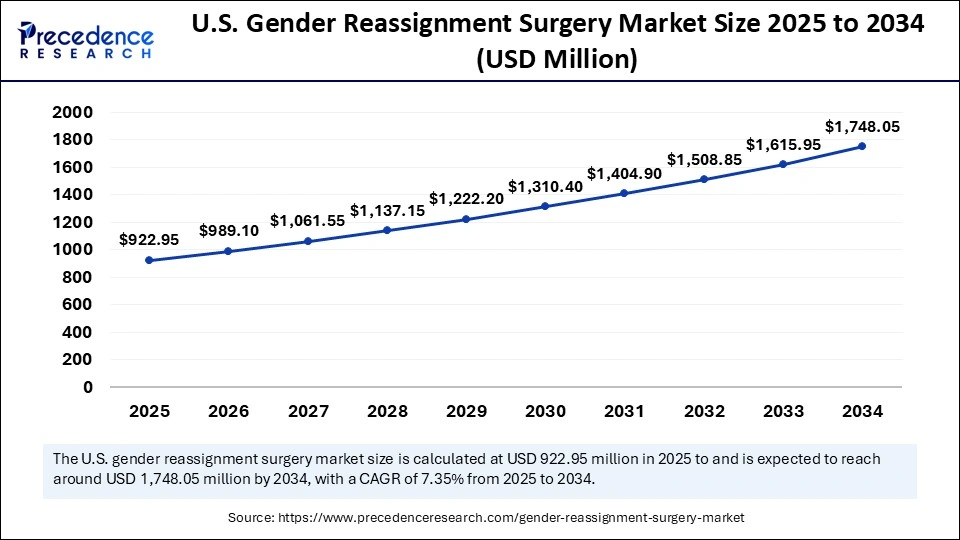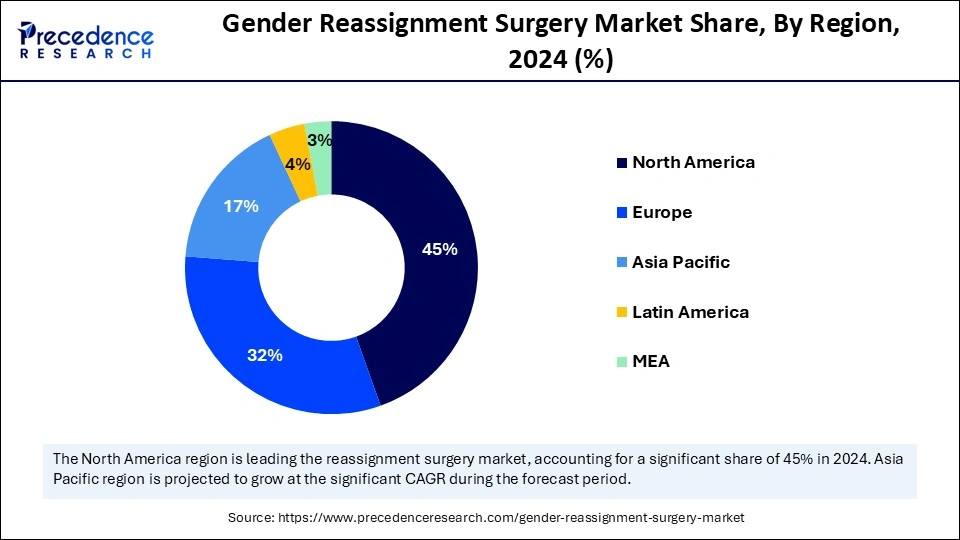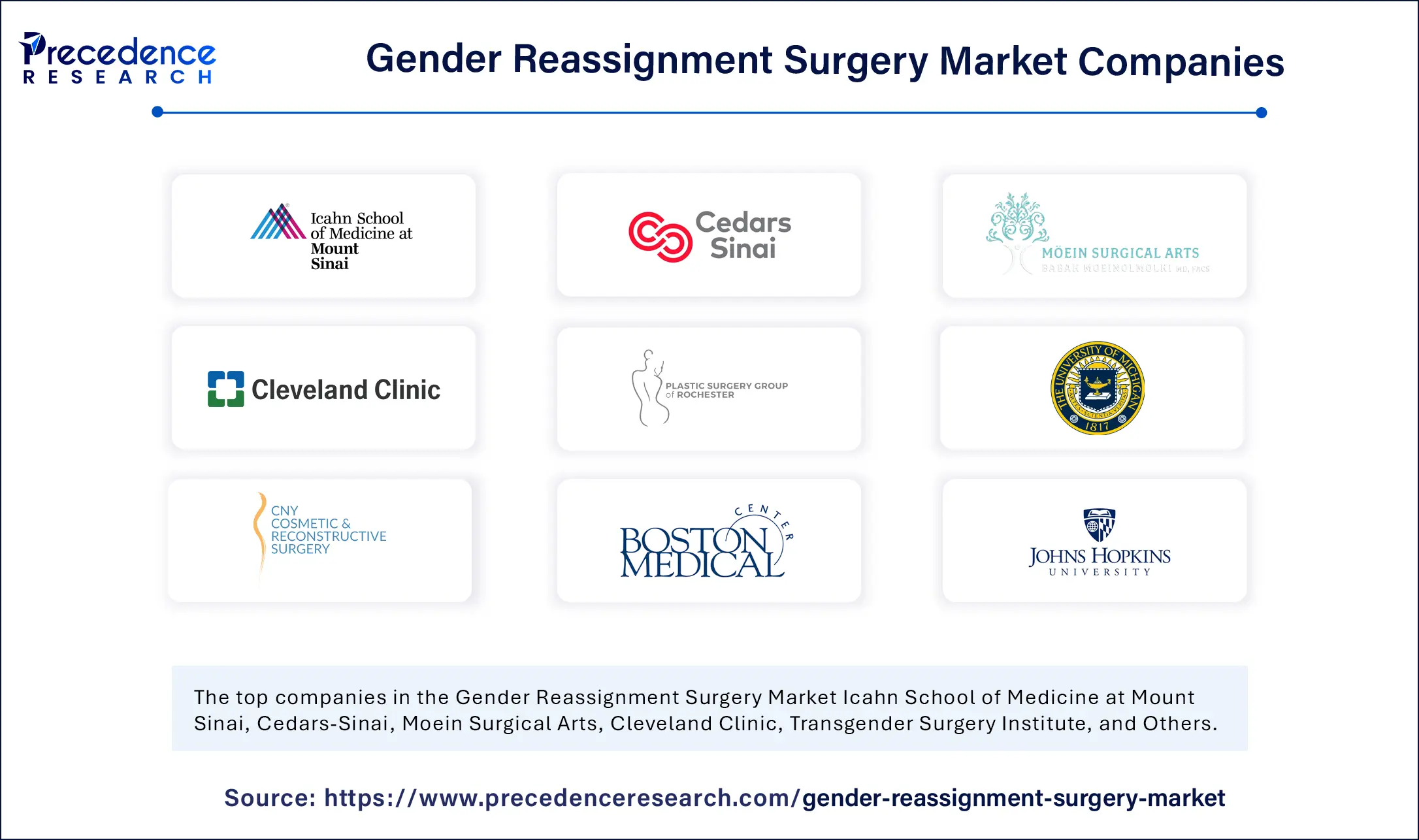List of Contents
What is the Gender Reassignment Surgery Market Size?
The global gender reassignment surgery market size is accounted at USD 2.93 billion in 2025 and predicted to increase from USD 3.14 billion in 2026 to approximately USD 5.51 billion by 2034, expanding at a CAGR of 7.27%% from 2025 to 2034. The gender reassignment surgery market is witnessing strong growth due to rising awareness of transgender identities, increasing government support, and growing demand for gender-affirming procedures.

Gender Reassignment Surgery MarketKey Takeaways
- In terms of revenue, the gender reassignment surgery market is valued at $2.93 billion in 2025.
- It is projected to reach $5.51 billion by 2034.
- The market is expected to grow at a CAGR of 7.27 % from 2025 to 2034.
- North America led the gender reassignment surgery market with the highest share of 45% in 2024.
- Asia Pacific is expected to expand the fastest CAGR in the market between 2025 and 2034.
- By gender transition, the female-to-male segment held the biggest market share in 2024.
- By gender transition, the male-to-female segment is expected to grow at a significant CAGR between 2025 and 2034.
- By procedure, the mastectomy segment captured the major revenue share in 2024.
- By procedure, the augmentation mammoplasty segment is expected to expand at a notable CAGR over the projected period.
How is Artificial Intelligence Revolutionizing Gender Reassignment Surgery?
Artificial intelligence (AI) has the ability to greatly revolutionize gender reassignment surgeries in terms of accuracy, personalization, and patient care. The potential innovation in gender-affirming surgery practices stems from the increased use of AI-powered facial recognition and simulation tools to assist surgeons. AI-guided surgical robots enhance surgical precision. Similarly, AI-driven 3D imaging individualizes custom anatomical modeling for tailored chest and genital surgeries.
In addition, AI is also being used in mental health platforms to provide pre- and post-operative emotional support to transgenders through customized chatbots that help monitor symptoms and feelings. AI could improve outcomes in surgery but, most importantly, provide far-reaching assistance to meet the wholeness of a transgender person's healthcare process and one's recovery. AI can monitor patients' recovery progress and recommend personalized care plans.
Market Overview
Gender reassignment surgery (GRS), also known as gender confirmation surgery or gender-affirming surgery, involves a series of surgical procedures that help an individual transition to their self-identified gender. GRS includes chest reconstruction, facial feminization or masculinization, and genital reconstruction, which includes phalloplasty or vaginoplasty. The gender reassignment surgical market is rapidly evolving due to consistent social acceptance of transgender individuals, advances in surgical procedures, and growing attention surrounding gender dysphoria with implications for rights regarding gender identity.
The growth of the gender reassignment surgery market is further fueled by supportive healthcare policies that are being prepared in many countries, along with insurance plans covering gender-affirming care. Increased attention to mental health, specifically around gender identity, has resulted in more individuals wanting surgical solutions in addition to other transitioning techniques. Increased attention and awareness of the LGBTQ+ community have also led to greater specialization in healthcare.
Gender Reassignment Surgery MarketGrowth Factors
- Trans Rights Awareness: Recognition of trans rights globally continues to grow. This awareness has led to increased societal acceptance regarding gender-affirming surgeries and the desire of others to pursue gender-affirming surgery without fear of stigma or discrimination.
- Social Insurance Expansion:Increasingly, both governments and private insurers include coverage for gender reassignment procedures, allowing for a larger percentage of individuals to be able to financially access surgery.
- Surgeon's Improvements: Changes and improvements in surgical techniques have led to an enhancement in precision, more efficient recovery times, and a better aesthetic result, improving confidence in patients who will undergo these surgeries.
- Mental Health Visibility: Increased visibility of mental health broadly has started to shine a light on the emotional and mental health consequences of gender-affirming surgeries and add to the social aspects of what can be considered as part of a holistic approach to transgender health.
- Media Representation: The increased representation of transgender people in various settings of media coverage and public roles is shattering barriers of acceptance and representation and invites more people to pursue gender reassignment.
Market Scope
| Report Coverage | Details |
| Market Size by 2034 | USD 5.51 Billion |
| Market Size in 2025 | USD 2.93 Billion |
| Market Size in 2026 | USD 3.14 Billion |
| Market Growth Rate from 2025 to 2034 | CAGR of 7.27% |
| Fastest Growing Region | Asia Pacific |
| Base Year | 2024 |
| Forecast Period | 2025 to 2034 |
| Segments Covered | Gender Transition, Procedure, and Region |
| Regions Covered | North America, Europe, Asia-Pacific, Latin America, and Middle East & Africa |
Market Dynamics
Drivers
Surgical Innovations are Improving Standards of Care in Gender-Affirming Surgery
Innovations in surgical technology are driving the growth of the gender reassignment surgery market. The utilization of robotics and 3D imaging is improving surgical preparation and patient outcomes. Technological advancements led to the emergence of minimally invasive surgeries, which have proven effective in enhancing the accuracy and safety of gender-affirming surgeries. In recent years, hospitals like Cleveland Clinic and Mount Sinai observed increased patient satisfaction and quicker recovery with laparoscopic and nerve-sparing approaches to vaginoplasty and phalloplasty.
Minimizing complications, scarring, and length of stay are important considerations for enhancing physical outcomes. As a result, the demand for minimally invasive surgery has increased. Additionally, advancements in perioperative care, including pain management protocols and sexual hormone stabilization, are now an integral component of achieving surgical goals and promoting successful outcomes. These advances not only build clinical confidence but encourage more individuals to consider surgical transition, which boosts the acceptance of GRS throughout the world and expands the market.
Restraint
Financial Barriers and Policy Constraints
Despite increased awareness and changes in the medical landscape, the gender reassignment surgery (GRS) market still faces challenges like financial and policy barriers. The complete cost of a gender transition includes a collated cost for routine hormone therapy, up to three surgeries, at least one requirement for counseling, and long-term follow-up. This can incur several hundreds and thousands of dollars of expenses. For a section of the transgender population, the cost of GRS procedures is prohibitive, especially in jurisdictions where there is no public health funding provided for these medical treatments.
For instance, in 2024, the UK's National Health Service (NHS) was criticized for long wait times and limited surgical capacity for gender reassignment surgery procedures. In the US, states passed bills in 2025 restricting Medicaid and some private insurers from offering coverage for gender-affirming type procedures, particularly those for minors. This inevitably limits individuals from attaining necessary procedures and negatively affects the mental health of many individuals who require important care. This dual burden will continue to inhibit market expansion.
(Source: https://www.lgbtmap.org)
Opportunity
Growing Awareness and Government Action
A significant opportunity in the gender reassignment surgery market lies in the rising global awareness about transgender rights and growing governmental support for gender-affirming care. Worldwide, there is much more public discourse around transgender health, with 2024 being the year with the greatest number of Pride events, awareness efforts, and legal wins in trans rights in countries such as Canada, Germany, and Australia. For Instance, in 2025, India's Union Health Ministry launched its first dedicated transgender healthcare centers under the Ayushman Bharat scheme, which allows for lower-cost surgeries and hormone therapy.
Taken together, these circumstances can be viewed as progressive and positive indicators of institutional endorsement and societal norms of increasing acceptance, allowing more potential patients to seek care without fear of social stigma and financial hardship. As advocacy movements increase and the healthcare systems around the world become more inclusive, the medical community is in a unique position to respond to the growing demand for gender reassignment surgery by providing methods of care that are respectful, tailored, and accessible.
Gender Transition Insights
Why did the Female-to-male Segment Dominate the Gender Reassignment Surgery Market in 2024?
The female-to-male segment dominated the market with the largest revenue share in 2024, primarily due to the use of mastectomies and genital reconstruction procedures in transmasculine persons, which have higher rates of acceptance and satisfaction, as well as advancements in surgical outcomes. More generally, with such procedures becoming available in countries like the U.S. and Canada through transgender health programs, specialized clinics, and continued confidence and satisfaction among the transmasculine population, this segment will indeed retain large revenues in the coming years. The acceptance and affordability of gender-affirming treatment options in North America further contribute to segmental growth.
On the other hand, the male-to-female segment is expected to grow at a significant CAGR during the forecast period owing to growing recognition, social acceptance, and rising desire for feminization surgery by trans women (e.g. breast augmentation, facial feminization surgery, vaginoplasty). Access to hormonotherapy and surgical infertility treatment options is likely to continue to grow within established healthcare infrastructure, specifically in countries like Thailand, India, and Germany. There is also a rise in medical tourism for MtF surgical procedures, and there is an increasing number of qualified and confident surgeons opening clinics for gender surgery in various nations, contributing to the growth of the segment.
Procedure Insights
What Made Mastectomy the Dominant Segment in the Market?
The mastectomy segment dominated the gender reassignment surgery market with a major revenue share in 2024. This is mainly due to its necessity in a female-to-male transition. For transmasculine individuals, it is typically one of the first surgical interventions to attain a more congruent chest appearance. Because of its relative procedural ease and high satisfaction from the patients, it is widely performed in both public and private health systems.
Mastectomy is an integral procedure in gender-affirming care. Because of increasing insurance coverage and low risk for complications, the demand for this procedure is on the rise. The numbers reflect that the chest masculinization surgery, particularly mastectomy, represents more than half (often significantly more than half) of the surgical procedures performed annually in most clinics across North America and Western Europe.
Meanwhile, the augmentation mammoplasty segment is expected to expand at a notable CAGR over the projected period due to the rising demand for enhanced feminine features from transgender women. There is a direct correlation between the growth of procedures and the access to estrogen hormone therapy to make tissue more amenable to a successful implant breast augmentation procedure. Many aesthetic surgery centers are offering gender-affirming packages, including augmentation procedures, which attract patients from around the world. Popular destinations such as Brazil and Thailand have seen an increased level of interest in breast augmentation, driving the growth of this segment.
Regional Insights
U.S. Gender Reassignment Surgery Market Size and Growth 2025 to 2034
The U.S. gender reassignment surgery market size is exhibited at USD 922.95 million in 2024 and is projected to be worth around USD 1,748.05 million by 2034, growing at a CAGR of 7.35% from 2025 to 2034.

What Factors Contribute to North America's Dominance in the Gender Reassignment Surgery Market?
North America dominated the market for gender reassignment surgery by holding the largest share in 2024. This is because of its advanced healthcare infrastructure, availability of insurance coverage for gender reassignment surgery, and inclusive healthcare policies regarding transgender medical treatment. The presence of specialized clinics, trained providers, laws ensuring accessibility to transgender care, and experienced surgeons have established the region as a global leader in gender-affirming procedures. In addition, with an increasing number of gender-affirming care centers in major urban areas like New York, San Francisco, etc., individuals there can access a greater diversity of gender-affirming options in a safer environment, while North America stands as the largest market for gender reassignment procedures.
The U.S. is at the forefront of acceptance of gender reassignment surgery due to political support for transgender rights. Several hospitals and clinics in the U.S. provide gender-affirming surgery, and there are shifting policies regarding coverage of gender-affirming treatment paid by federal and state-funded healthcare programs such as Medicaid. Furthermore, as trans-identified individuals become comfortable with their identities, there is a high demand for GRS. Robust advocacy groups and support networks for trans individuals contribute to market expansion.

What Opportunities Exist in the Gender Reassignment Surgery Market Within Asia Pacific?
Asia Pacific is expected to grow at the fastest CAGR in the coming years, driven by a changing society, increasing medical tourism, and government support for transgender health. In recent years, Thailand, India, South Korea, and Vietnam have invested significantly in the number of facilities that perform gender-affirming surgeries. Thailand's Public Health Ministry has allocated over THB 145 million (USD 4.3 million) in its 2025 budget to hormone therapy and related care for around 200,000 transgender individuals. This represents a national commitment to transgender health. India has attracted considerable domestic and international tourism with its lower costs and good surgical quality. Technological advancements, specifically in robotic assistance and 3D technologies, are improving surgical precision throughout APAC.
(Source: https://www.idea.int)
China is incrementally making strides in transgender healthcare. The country's recent positive reforms that reduce the minimum age for gender reassignment surgery from 20 to 18 and eliminate the requirement for gender-affirmation surgeries to complete compulsory appointments for a psychological assessment highlight its major contribution to market growth. Some specialized clinics, for e.g. Peking University Third Hospital, are expanding their gender-affirming services. So, even with all the political and legal challenges for transgender rights in China, these positive changes highlight China's role in advancing gender-affirming care in the Asia Pacific.
Recent Developments
- In May 2025, Johnson & Johnson MedTech launched the MENTOR MemoryGel Enhance Breast Implants in the U.S., filling a critical gap in comprehensive breast cancer care for women who have undergone a mastectomy.
(Source: https://www.jnjmedtech.com) - In June 2024, Nepal successfully conducted its first sex change surgery at Tribhuvan University Teaching Hospital, marking a significant step toward transgender healthcare rights and inclusivity in the country.
(Source: https://www.deccanherald.com)
Gender Reassignment Surgery Market Companies

- Icahn School of Medicine at Mount Sinai
- Cedars-Sinai
- Moein Surgical Arts
- Cleveland Clinic
- Transgender Surgery Institute
- Plastic Surgery Group of Rochester
- Regents of the University of Michigan
- CNY Cosmetic & Reconstructive Surgery
- Boston Medical Center
- The Johns Hopkins University
- Kaiser Permanente
- University of California, San Francisco Center of Excellence for Transgender Health
- New York Presbyterian Hospital
- Mayo Clinic
Segments Covered in the Report
By Gender Transition
- Male-to-female
- Female-to-male
By Procedure
- Augmentation Mammoplasty
- Voice Feminization Surgery
- Reduction Thyrochondroplasty
- Orchiectomy
- Vaginoplasty
- Chest Masculinization Surgery
- Scrotoplasty
- Hysterectomy
- Phalloplasty
- MastectomyMetoidioplasty
- Facial Feminization Surgery
By Region
- North America
- Europe
- Asia Pacific
- Latin America
- Middle East and Africa
For inquiries regarding discounts, bulk purchases, or customization requests, please contact us at sales@precedenceresearch.com
Frequently Asked Questions
Ask For Sample
No cookie-cutter, only authentic analysis – take the 1st step to become a Precedence Research client